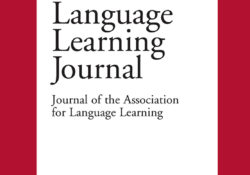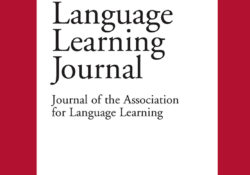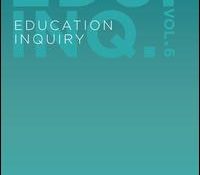tandfonline.com har udgivet en rapport under søgningen “Teacher Education Mathematics”: Teaching basic map concepts in three countries: Azerbaijan, Hungary and United Arab Emirates Link til kilde
Like this:
Like Loading...
eric.ed.gov har udgivet: This paper is based on data gathered during visits to Uganda and Malawi, conducted by the International Math-teacher Professionalization Using Lesson Study (IMPULS) project and the Japanese International Cooperation Agency (JICA). The author’s observations and experiences highlighted misconceptions about lesson study. The paper concludes that some key factors can be viewed as either affordances, or constraints, on practice, while others are best understood against several misconceptions that seem to be common outside Japan. Link til kilde
Like this:
Like Loading...

tandfonline.com har udgivet en rapport under søgningen “Teacher Education Mathematics”: ABSTRACT ABSTRACT Traditionally emphasizing justice, equality and inclusion, education policies in the Nordic countries have incorporated neoliberal features during the last three decades, but to varying extents. These changes have important, multidimensional implications, but the variations have been addressed in few comparative Nordic studies. Thus, this article explores the potential to strengthen comparisons of education regimes in the Nordic countries generally, and social justice and marketization aspects more specifically, by using existing datasets and databases. It initially elaborates the concepts of justice and marketization of education. Using Iceland, Norway and Sweden as examples, it explores the relevance, accessibility and comparability of some of the larger international and national statistical databases, and hence their potential to enable such comparisons. These data… Continue Reading →
Like this:
Like Loading...
eric.ed.gov har udgivet: This study investigated common features of students’ attitudes towards studying science and mathematics in comprehensive and secondary schools in three countries. Data were obtained by conducting a survey (N = 581) in Norway, Finland and Russia. A Confirmatory factor analysis (CFA) provided a model with a three-factor solution consisting of factors: the perception of the teacher, anxiety towards science and mathematics, and motivation. The results suggest that most students are motivated to study sciences and mathematics. Data analysis indicate gender differences in attitudes to students’ future studies and career plans. Most girls recognized the importance of these subjects for their future studies and careers, while boys showed more interest than girls in local career opportunities in industry. Teachers have a significant role in directing students’ attitudes toward… Continue Reading →
Like this:
Like Loading...
tandfonline.com har udgivet en rapport under søgningen “Teacher Education Mathematics”: ABSTRACT ABSTRACT The Netherlands are quite unique in that the Dutch have always learned various foreign languages. Until 1940, French was the most important foreign language. Between roughly 1870 and 1970, Dutch learners in grammar schools and higher secondary schools were even obliged to learn three foreign languages: French, German and English. Since 1970, however, English has become the first foreign language, and proficiency in French and German has declined. As for methodology, Dutch foreign language teaching/learning (FLT) has always taken a practical stand, in which the question ‘does it work?’ is paramount. This article provides an overview of the developments that have characterised Dutch FLT from approximately 1500 to the present day. Link til kilde
Like this:
Like Loading...
tandfonline.com har udgivet en rapport under søgningen “Teacher Education Mathematics”: ABSTRACT ABSTRACT The paper gives an overview of FLT in the German-speaking regions of Europe from medieval times to the present day, within a framework of language politics, communicative needs and educational ideologies. The languages addressed are French, Italian, Spanish, English, Russian and Turkish. Basic social and professional data of the various groups of teachers are provided. Formats of teaching discussed range from private tuition to state school curricula. Link til kilde
Like this:
Like Loading...
tandfonline.com har udgivet en rapport under søgningen “Teacher Education Mathematics”: ABSTRACT ABSTRACT In this study we examine how the academic–vocational divide is manifested today in Finland, Iceland and Sweden in the division between vocationally (VET) and academicallyoriented programmes at the upper-secondary school level. The paper is based on a critical re-analysis of results from previous studies; in it we investigate the implications of this divide for class and gender inequalities. The theoretical lens used for the synthesis is based on Bernstein´s theory of pedagogic codes. In the re-analysis we draw on previous studies of policy, curriculum and educational praxis as well as official statistics. The main conclusions are that contemporary policy and curriculum trends in all three countries are dominated by a neo-liberal discourse stressing principles such as “market relevance”… Continue Reading →
Like this:
Like Loading...
tandfonline.com har udgivet en rapport under søgningen “Teacher Education Mathematics”: Abstract Abstract The subject of research in this paper is higher-education competitiveness on account of its impact on the enhancement of social and economic competitiveness, as well as on the growth of human capital and creation of social knowledge. The purpose of this paper is to group the selected European countries according to higher-education competitiveness, by means of the hierarchical cluster analysis method, with a special focus on the position of Serbia. Higher-education competitiveness in the chosen countries is analysed by means of three indicators of competitiveness: the ratio of the number of students per number of inhabitants, the number of students per number of employed, as well as the amount of budgetary funds allocated per student. The research results… Continue Reading →
Like this:
Like Loading...
tandfonline.com har udgivet en rapport under søgningen “Teacher Education Mathematics”: Abstract Abstract The aim of this paper is to reveal the current situation of gifted education in Turkey. The talents that are valued and the concepts of giftedness were discussed according to the country’s cultural and political perspectives. Studies that had been made to analyze the beliefs of lay people, teachers and parents with respect to gifted students and their education were mentioned. Programs such as special schools (science high schools, private school programs), resource rooms and after-school programs (Science and Art Centers [SACs], Education Programs for Talented Students [EPTS], child universities) were introduced. How these programs currently function was also discussed. In addition, it has emerged that the studies carried out in the past 10 years focused on the… Continue Reading →
Like this:
Like Loading...
tandfonline.com har udgivet en rapport under søgningen “Teacher Education Mathematics”: ABSTRACT Formulae display:?Mathematical formulae have been encoded as MathML and are displayed in this HTML version using MathJax in order to improve their display. Uncheck the box to turn MathJax off. This feature requires Javascript. Click on a formula to zoom. ABSTRACT A selection of secondary school mathematics textbooks from twelve countries on five continents was analysed to better understand the support they might be in teaching and learning mathematical problem solving. Over 5700 tasks were compared to the information provided earlier in each textbook to determine whether each task could be solved by mimicking available templates or whether a solution had to be constructed without guidance from the textbook. There were similarities between the twelve textbooks in the sense… Continue Reading →
Like this:
Like Loading...







